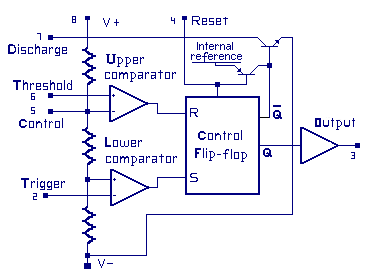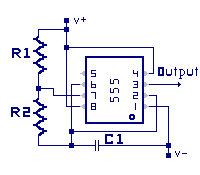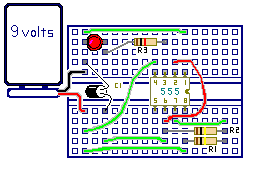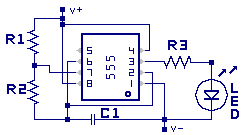This is Book 2
Chapter 7 - AC and Hertz
Chapter 8 - Magnetism
Chapter 8.2 - Inductors
Chapter 9 - Power Supply
Chapter 9.2 - Power Supply Filters
Chapter 10 - IC's and Amplifier
Chapter 10.2 - OP AMP Feedback and Unity Gain
Chapter 10.3 - OP AMP Non-Inverting
Chapter 10.4 - OP AMP Inverting
Chapter 11 - 555 Timer
Chapter 11.2 - Counters
Chapter 12 - Logic
Back To The Guide
Take Me Home
555 Timer Oscillator
In this chapter we are looking at the 555 IC used as a timer oscillator. This
is a very versatile and interesting integrated circuit that has been used in
many university courses, and in the electronic industry. There are times
when a oscillator or tone generator of some type is needed. The lower
priced, lower precision solution of using the 555 or the 7555 chip will work just
fine. There is an added benefit of saving several hundred dollars or more over
a commercial generator. The 7555 IC, using advanced technology, consumes less power
than the 555, thus commanding a higher price tag.
At the foundation of the 555, we start with input circuitry which has two
Op Amps working as comparators and called the lower and upper comparator. The
comparators have no feedback so their output is either high or low. They feed into
a toggle circuit called a Flip-Flop. The output is a unity amplifier, Additionally
the 555 has a few other components inside.
Pin layout for the 555 chip is an 8-pin dual inline pin (8-dip) arrangement.
The case is marked with either a small circle, or a u-shaped notch at one end of
the top surface of the body. Moving counter-clockwise (anti-clockwise) from that
marker, the pins are numbered 1, 2, 3, and 4 on one side of the body, and continue
on the other side as 5, 6, 7, and 8.
This illustration shows the basic 555 circuitry.
There are three internal resistors, acting as a voltage divider between V+ and V-.
The divider sets the input voltage on the non-inverting lower comparator to 1/3
supply voltage and the inverting input voltage (the upper comparator) to 2/3
supply voltage.
In previous sections and labs we learned how the voltage divider and the Op Amps
work. When an Op Amp is a comparator there is no feedback. This means that the
output is either high or it is low (review state-1 and state-3 in eariler sections). Now we
will take a brief look at the Flip-Flop component in the 555 circuitry.
Flip-Flop Truth Table
A truth table tells how the IC works in table form. This short hand
tool makes quick work of learning how any Black Box circuit works.
Here is how the Flip-Flop circuit Truth Table works.
In a truth-table 0 represents no voltage, off, or false,
and 1 represents high voltage, on, or true.
NOTE: In a truth-table the IC inputs determine the IC outputs.
You may have some control over inputs but as a black
box the IC controls its outputs based on its inputs.
Truth Table for the Flip-Flop inside the 555
R S Not-Q Q
0 1 0 1
1 0 1 0
There are two input R, and S and two outputs Q and not-Q.
In this table when R is 0 and S is 1
the outputs are Not-Q is 0 and Q is 1, as indicated.
In the other state when R is 1 and S is 0
then Not-Q is 1 and Q is 0.
The other two options where R and S are either both 0 or both 1
there is no change to the outputs Q and Not-Q from where ever they are.
This will become clearer in a moment.
The 555 Pin-out (description)
Pin 1: V-, circuit ground or common
Pin 2: Trigger Input
Pin 3: Output
Pin 4: Reset, during a falling voltage level
the 555 output is reset to low voltage
Pin 5: Control input
Pin 6: Threshold
Pin 7: Discharge
Pin 8: V+
The 555 in Astable Multivibrator
This general oscillator with the big name, has a simple meaning.
The astable portion means that there is NO STABLE output. The multivibrator
portion means that there are different output-states.
In other words the output changes all the time. In this circuit, by wiring two resistors
R1 and R2 and a capacitor C1 of proper values, to the inputs as shown in the
illustration, the 555 operates as an oscillator.
Theory of Operation
At time-period 0, with power applied to the circuit, the lower comparator output is at
voltage 1. The upper comparator output is at voltage 0. The output on the 555 IC
is at voltage 1. R1 and R2 start charging capacitor C1.
At some time-period, 1, the capacitor voltage level at 555 IC pin 2, which is the lower
comparator inverting input, becomes higher then the 1/3 supply voltage fed to the
non-inverting input. The lower comparator output now switches low, which
supplies a 0 voltage to the S flip-flop input.
The capacitor continues to charge and at time-period 2, the upper comparator at
pin 6, being an non-inverting input becomes greater then 2/3 of the supply voltage,
causing this comparator output to go high, which supplies a 1 voltage to the R
input of the flip-flop.
At this moment the flip-flop will switch output states. Output Q goes from
a 1 to a 0. This drives the unity amplifier to follow Q,
to provide a 0 at the output pin number 3 of the IC. at the same moment in time, Not-Q is switched high,
which turns on the discharge transistor. Now C1 starts to discharge through
R2 and the internal transistor.
At time-period 3, the 555 IC pin 6 upper comparator voltage drops below 2/3 supply
voltage, which caused the upper comparator to supply a 0 to the R input of the Flip-flop.
The C1 capacitor voltage continues to discharge until time-period 4, where 555 IC pin 2
drops below the 1/3 supply voltage on the lower comparator. At this moment the lower
comparator output switches to a 1 causing the flip-flop to switch output states
with Q now at 1 and not-Q now at 0. The output on the IC pin 3 is now high again.
The discharge transistor is shut off, and the cycle starts over at time 0.
This circuit has just passed through one timing cycle and it starts over again with
the capacitor starting to charge through R1 and R2. Now that we know the cycle,
how fast does all this happen?
This is where we apply those RC time constants we studies earlier in book 1.
The full RC time cycle triggering the flip-flop circuitry and changing the output
stage is a set of two half cycles. The first half-cycle is for the charging of
C1 through R1 and R2. The second half-cycle is the discharging of C1 through R2.
First Half-cycle t1 = 0.693 x (R1 + R2) x C1
During this cycle the output is HIGH.
Second Half-Cycle t2 = 0.693 x R2 x C1.
During this cycle the output is LOW.
Astable Multivibrator class circuits
can be implemented using IC including this 555 Timer or the 7555 IC timer, an array of different
logic gates, transistorized circuits, and older technologies include vacuum tube
based circuitry and relay based devices.
Experiment with the 555 Timer IC and an LED
Go to the work bench.
Review the
Resistor Color Code chart and wire up the kit as described. Perform the lab,
and record your results.
Parts List:
1 9-volt battery
1 Battery power clip
1 555 IC - U1
1 10 mmf capacitor - C1
1 1 k ohm resistor - R3
(brown, black, red)
2 100 k ohm resistor - R1, R2
(brown, black, yellow)
1 red light emitting diode
1 experimenters board
Miscellaneous:
hookup wire
NOTES: The flat side of the LED is toward the V- side of the circuit.
The minus side of the C1 capacitor is toward the V- side of the circuit.
« Previous Chapter Next Chapter »
Email us: info@shoeboxkits.com






